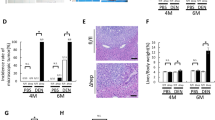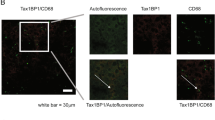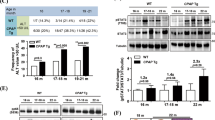Abstract
The tumor suppressor p53 has an important role in inducing cell-intrinsic responses to DNA damage, including cellular senescence or apoptosis, which act to thwart tumor development. It has been shown, however, that senescent or dying cells are capable of eliciting inflammatory responses, which can have pro-tumorigenic effects. Whether DNA damage-induced p53 activity can contribute to senescence- or apoptosis-associated pro-tumorigenic inflammation is unknown. Recently, we generated a p53 knock-out rat via homologous recombination in rat embryonic stem cells. Here we show that in a rat model of inflammation-associated hepatocarcinogenesis, heterozygous deficiency of p53 resulted in attenuated inflammatory responses and ameliorated hepatic cirrhosis and tumorigenesis. Chronic administration of hepatocarcinogenic compound, diethylnitrosamine, led to persistent DNA damage and sustained induction of p53 protein in the wild-type livers, and much less induction in p53 heterozygous livers. Sustained p53 activation subsequent to DNA damage was accompanied by apoptotic rather than senescent hepatic injury, which gave rise to the hepatic inflammatory responses. In contrast, the non-hepatocarcinogenic agent, carbon tetrachloride, failed to induce p53, and caused a similar degree of chronic hepatic inflammation and cirrhosis in wild type and p53 heterozygous rats. These results suggest that although p53 is usually regarded as a tumor suppressor, its constant activation can promote pro-tumorigenic inflammation, especially in livers exposed to agents that inflict lasting mutagenic DNA damage.
This is a preview of subscription content, access via your institution
Access options
Subscribe to this journal
Receive 50 print issues and online access
$259.00 per year
only $5.18 per issue
Buy this article
- Purchase on Springer Link
- Instant access to full article PDF
Prices may be subject to local taxes which are calculated during checkout




Similar content being viewed by others
References
Hanahan D, Weinberg RA . Hallmarks of cancer: the next generation. Cell 2011; 144: 646–674.
Thorgeirsson SS, Grisham JW . Molecular pathogenesis of human hepatocellular carcinoma. Nat Genet 2002; 31: 339–346.
Kang TW, Yevsa T, Woller N, Hoenicke L, Wuestefeld T, Dauch D et al. Senescence surveillance of pre-malignant hepatocytes limits liver cancer development. Nature 2011; 479: 547–551.
Fausto N . Mouse liver tumorigenesis: models, mechanisms, and relevance to human disease. Semin Liver Dis 1999; 19: 243–252.
Levine AJ, Oren M . The first 30 years of p53: growing ever more complex. Nat Rev Cancer 2009; 9: 749–758.
Livni N, Eid A, Ilan Y, Rivkind A, Rosenmann E, Blendis LM et al. p53 expression in patients with cirrhosis with and without hepatocellular carcinoma. Cancer 1995; 75: 2420–2426.
Sarfraz S, Hamid S, Siddiqui A, Hussain S, Pervez S, Alexander G . Altered expression of cell cycle and apoptotic proteins in chronic hepatitis C virus infection. BMC Microbiol 2008; 8: 133.
Greenblatt MS, Feitelson MA, Zhu M, Bennett WP, Welsh JA, Jones R et al. Integrity of p53 in hepatitis B x antigen-positive and -negative hepatocellular carcinomas. Cancer Res 1997; 57: 426–432.
Kodama T, Takehara T, Hikita H, Shimizu S, Shigekawa M, Tsunematsu H et al. Increases in p53 expression induce CTGF synthesis by mouse and human hepatocytes and result in liver fibrosis in mice. J Clin Invest 2011; 121: 3343–3356.
Krizhanovsky V, Yon M, Dickins RA, Hearn S, Simon J, Miething C et al. Senescence of activated stellate cells limits liver fibrosis. Cell 2008; 134: 657–667.
Abbott A . Laboratory animals: the Renaissance rat. Nature 2004; 428: 464–466.
Tong C, Li P, Wu NL, Yan Y, Ying QL . Production of p53 gene knockout rats by homologous recombination in embryonic stem cells. Nature 2010; 467: 211–213.
Rajewsky MF, Dauber W, Frankenberg H . Liver carcinogenesis by diethylnitrosamine in the rat. Science 1966; 152: 83–85.
Verna L, Whysner J, Williams GM . N-nitrosodiethylamine mechanistic data and risk assessment: bioactivation, DNA-adduct formation, mutagenicity, and tumor initiation. Pharmacol Ther 1996; 71: 57–81.
Polyak K, Xia Y, Zweier JL, Kinzler KW, Vogelstein B . A model for p53-induced apoptosis. Nature 1997; 389: 300–305.
Farazi PA, DePinho RA . Hepatocellular carcinoma pathogenesis: from genes to environment. Nat Rev Cancer 2006; 6: 674–687.
Newell P, Villanueva A, Friedman SL, Koike K, Llovet JM . Experimental models of hepatocellular carcinoma. J Hepatol 2008; 48: 858–879.
Kemp CJ . Hepatocarcinogenesis in p53-deficient mice. Mol Carcinog 1995; 12: 132–136.
Kuraishy A, Karin M, Grivennikov SI . Tumor promotion via injury- and death-induced inflammation. Immunity 2011; 35: 467–477.
Kemp CJ, Donehower LA, Bradley A, Balmain A . Reduction of p53 gene dosage does not increase initiation or promotion but enhances malignant progression of chemically induced skin tumors. Cell 1993; 74: 813–822.
van Gijssel HE, Maassen CB, Mulder GJ, Meerman JH . p53 protein expression by hepatocarcinogens in the rat liver and its potential role in mitoinhibition of normal hepatocytes as a mechanism of hepatic tumour promotion. Carcinogenesis 1997; 18: 1027–1033.
Acknowledgements
We thank Jiaohong Wang, Shoudong Ye and Zhengmao Lu for technical assistance. This work was supported by a NIH grant to QLY (R01OD010926).
Author information
Authors and Affiliations
Corresponding authors
Ethics declarations
Competing interests
The authors declare no conflict of interest.
Additional information
Supplementary Information accompanies the paper on the Oncogene website
Supplementary information
Rights and permissions
About this article
Cite this article
Yan, HX., Wu, HP., Zhang, HL. et al. DNA damage-induced sustained p53 activation contributes to inflammation-associated hepatocarcinogenesis in rats. Oncogene 32, 4565–4571 (2013). https://doi.org/10.1038/onc.2012.451
Received:
Revised:
Accepted:
Published:
Issue Date:
DOI: https://doi.org/10.1038/onc.2012.451
Keywords
This article is cited by
-
Expression of molecular markers and synergistic anticancer effects of chemotherapy with antimicrobial peptides on glioblastoma cells
Cancer Chemotherapy and Pharmacology (2024)
-
In vivo Study of a Newly Synthesized Chromen-4-one Derivative as an Antitumor Agent against HCC
Journal of Gastrointestinal Cancer (2022)
-
The landscape of aging
Science China Life Sciences (2022)
-
EP300 knockdown reduces cancer stem cell phenotype, tumor growth and metastasis in triple negative breast cancer
BMC Cancer (2020)
-
Anticancer strategies by upregulating p53 through inhibition of its ubiquitination by MDM2
Medicinal Chemistry Research (2020)



